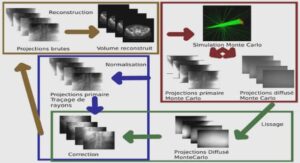Physical Layer Security Techniques
Artificial Noise and Artificial Fading
Artificial Noise
In multi-antenna systems, Artificial noise is one of the most popular techniques to guarantee security at the physical layer Goel & Negi (2008); Khisti & Wornell (2010). The basic idea behind artificial noise technique is that the channel state information (CSI) of the main channel is unknown by the eavesdroppers. Thus, they will be distracted and unable to decode the transmitted information-bearing symbols. x = u+v, (1.3)
where u is the message and v is the added artificial noise. v is chosen such that hm v= 0. Then, the signal received by the legitimate receiver Bob is :
yb = hm x+nb = hm(u+v) +nb (1.4)
yb = hm u+nb
whereas the signal received by the eavesdropper Eve is :
ye = hw x+ne = hw u+hw v+ne
ye = hw u+hw v+ne (1.5)
Artificial Fading
Different from the artificial noise, the main idea of artificial fading is to weight the transmitted information symbol s randomly by a weighting coefficient k. The transmitted signal could be written as x = ks, (1.7)
with a constraint that hmk = 1, where hm is the channel coefficient between the transmitter and the legitimate receiver. Therefore, the received signal at the legitimate receiver becomes ym = hmks+nm = s+nm, (1.8)
where nm is the AWGN at the receiver. Therefore, the receiver will be able to decode its received signal directly without any channel coefficient hm, whereas the signal received at the eavesdropper becomes yw = hwks+nw, (1.9)
where hw is the channel coefficient between the transmitter and the eavesdropper, and nw is the AWGN at the eavesdropper. The authors in Wang et al. (2015c) compared between artificial noise and artificial time-varying multiplicative noise that they named it artificial fast fading scheme since this scheme results in an equivalent fast fading channel for the eavesdropper. They concluded that the artificial noise scheme achieves a larger secrecy rate when the transmitter has more antennas than the eavesdropper. Otherwise the artificial fast fading is superior. Motivated by their results, they proposed a hybrid artificial noise-artificial fast fading scheme to achieve a better secrecy performance than either schemes. As mentioned in Wang & Yang (2012), the unwanted wireless communication links can deliberately be corrupted by double beam switching of the smart antenna array as a novel concept of artificial fading. In Wang et al. (2014a), artificial fast fading was applied by randomly weighting the information symbols at different transmitting antennas in a special way so that the eavesdropper’s channel is a fast fading channel while that of the intended receiver is an additive white Gaussian noise channel. In Song (2018), the researchers proposed a novel cross layer design by combining artificial fast fading with secret-keys in the upper layer crypto-system to nullify the information leakage for any number of antennas at the eavesdropper. For both artificial noise and artificial fading, it is assumed that the transmitter and the receiver are acquainted of the main channel. Subsequently, the legitimate channel’s security performance becomes easily assailable by the eavesdropper. Moreover, the mobility of the legitimate nodes, with the artificial noise and artificial fading techniques, which adds complexity due to the rapid changes in the characteristics of the legitimate channels, has not yet been investigated.
Relay and Cooperative Methods
In the context of relay networks, we can divide the security issues in two broad categories, namely trusted relays and untrusted relays.
Trusted Relays: The eavesdropper and the relays are two separated network entities. To counteract external eavesdroppers, the relays can play various roles. They may be acting as traditional relays or both jamming partners as well as relaying components in order to strengthen the secure transmission. The concept of trusted relays was used in Arafa et al. (2018) to secure downlink NOMA systems. In Atallah & Kaddoum (2019), the source and the destination share the CSI of source-trusted relay-destination link to encode the messages and to map the transmission. The authors in Dahmane et al. (2017) introduced a weighted probabilistic and trust-aware strategy to provide high security and integrity level with less relays. In addition, in Waqas et al. (2018), secret key generation was investigated in D2D communications in the presence of trusted and untrusted relays. Another novel noise-forwarding strategy called deaf helper phenomenon was also proposed in Lai & El Gamal (2008); to confuse the eavesdropper, dummy codewords independent of the secret message are sent by the full-duplex relays. This strategy was also investigated in Bassily & Ulukus (2013, 2012). In Li et al. (2013), a security-oriented transmission scheme was proposed in cognitive radio network CRN with the aid of multiple relays. To maximize the secondary user (SU) link secrecy capacity, both cooperative jamming techniques and beamforming are used to improve the performance of the SU while providing a good protection to the primary users (PUs). The proposed scheme contributes in securing the SU’s transmission while the SNR attenuation at the PU receiver is kept acceptable. Another interesting security scheme, in a centralized cognitive radio network (CRN), was proposed in Wen et al. (2019), where the base station is communicating with a PU in the presence of an eavesdropper, while the SU acts as a friendly jammer. This jammer could be fully trusted or untrusted when it does not send jamming signals all the time for selfish reasons. Therefore, a selection criterion was adopted to evaluate the trust degree of this jammer and its effect on the secrecy performance.
Untrusted Relays:
Unlike the aforementioned case, the relay itself is sometimes considered an untrusted user; it acts both as an eavesdropper and a traditional relay, i.e.First studied in Oohama (2007) for general relay channels, this type of model implies that the source desires to use the relay to communicate with the destination while it intends to shield the relay of the message. Under the assumption that some of the messages that have been transmitted are confidential to the relay, coding problems associated with the relay-wiretap channel are studied. In Shrestha et al. (2019), the authors studied the secrecy performance of a multi-hop ad-hoc wireless network in the presence of untrusted and trusted relays in each hop. To perform the transmission, the most secure relay will be chosen in each hop to deliver the message. The researchers in El Shafie et al. (2017) proposed a new scheme to secure a wireless network in the presence of untrusted relays. The destination and another cooperative jammer inject artificial noise to jam these relays for two reasons; to prevent them from intercepting their received messages and to help them harvest energy to charge their batteries. In Atallah & Kaddoum (2017) and Atallah & Kaddoum (2019), new location-based multicasting techniques were proposed to reduce the possibility of an untrustworthy relay intercepting the whole transmitted message. As an interesting result, the use of an untrustworthy relay can still be beneficial in increasing the secrecy capacity Yener & He (2010); Jeong et al. (2012); Sun et al. (2012); Kuhestani et al. (2016). In the following section, we will explore a very important cooperating method in physical layer security; the cooperative jamming technique, which is a promising method and has attracted significant attention. This method was proposed originally for a multiple access wiretap channel, where multiple legitimate users wish to establish secure communications with an intended receiver in the presence of an eavesdropper. Since an eavesdropper could be part of a wireless network as an untrusted relay, we will explore here some major types of the eavesdroppers’ behaviors.
Cooperative Jamming
To confuse the eavesdropper, a special technique called cooperative jamming can be used where an artificial noise is introduced by a helpful interferer. The secrecy performance analysis with cooperative jamming was studied in the presence of the impulsive noise Atallah et al. (2019), aggressive relays Atallah & Kaddoum (2016), mixture Gamma distribution Kong & Kaddoum (2019), αμ fading channels Kong & Kaddoum (2019), Hybrid Millimeter Wave Networks Vuppala et al. (2018) , and device-to-device (D2D)-enabled cellular networks Tolossa et al. (2018). In the following section, we will introduce the cooperative jamming techniques which are used to increase the physical layer security. To improve the secrecy capacity, we should either increase the legitimate receiver’s SNR or decrease the eavesdropper’s SNR.
INTRODUCTION |





